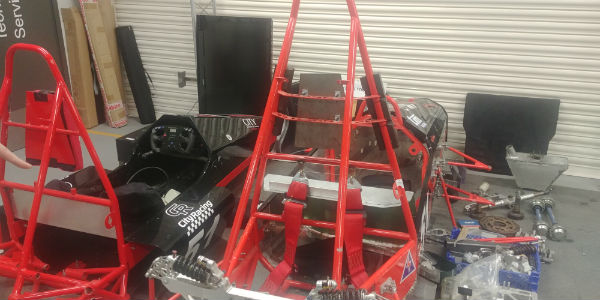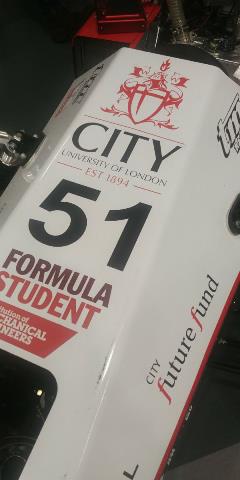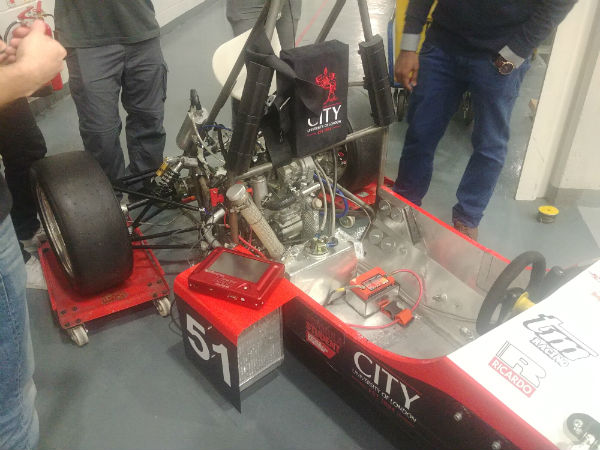Sporting a half-aluminium monocoque with steel frame, CR18 is one of a long line of cars in City Racing’s workshop, which also includes former years’ entries in a corner of the garage area. While 2015’s car has been stripped and converted into a decent simulator (with future plans for a full hydraulic force-feedback system!) and the 2017 car lying in parts for a conversion project, the workshop is a hive of activity with CR18 at its core. “We know the car looks good, but unfortunately it’s had no track testing” shrugs Calum, new to FS and current team lead, “so, without any meaningful feedback data, we don’t know exactly how good a car the team built last year is. None of that was helped by having to swap out the TM530 engine after it blew up at a dyno’s workshop, but we plan to learn all we can from last year’s submission and integrate that into the new build going forward.”

Having attended Silverstone for the last couple of years, I hadn’t seen the team on track and was keen to find out what has happened with them and their most recent entry, CR18. “Unfortunately, 2018’s entry didn’t manage to pass scrutineering, all down to the MAP sensor on our plenum,” explains Chris, one of the final year students on the team and the team’s head of suspension. “It was 90˚C outside of the roll envelope and of course we only discovered this when we assembled on site. It just wasn’t something that was carefully considered at the design stage but we live and learn – at least that’s one of the advantages of this competition, so we’re keeping an eye on compliance this time.”
A large fixture in the team’s history and a great asset for incoming team members is their Team Principal Roger Valsler. Now a visiting lecturer in semi-retirement, he is heavily involved in both F1 in Schools and the FS team at City University and speaks excitedly about engineering students getting involved. “Most of the team members we’ve seen over the years work very hard and these guys are no exception,” he explains. “The issue we have is not budgets; but it’s having the time to get the car built together properly. Building the car helps develop their hands-on mechanical engineering skills, though in the beginning it does take more time to get up to speed and they often run out of space.” Given Roger’s heritage from McLaren F1 in the 60s, building race cars is in his blood, and he is keen to encourage the team to do better each year. “Frankly, where else are engineering students going to get the opportunity to design and build a car from scratch? It’s a great opportunity and everyone should do it if they have the chance!”
 Calum agrees with this sentiment. “This is a promising year, the university is very supportive and as a team we have the right connections with the academic staff and the wider university to get the parts, resources and opportunities that we need – as long as it’s justifiable, of course. This does mean that our performance with the CR19 entries has to reflect the increased investment and we’re looking to deliver a better car than last time to show both our internal and external supporters, that we can do this reliably.” Likewise, the team can also rely on the skills of the Project Technician Earl Peters for all round technical and practical support, who no doubt will oversee all the CNC’ing, plasma cutting and TIG-welding as the team comes to realising their designs, early next year.
Calum agrees with this sentiment. “This is a promising year, the university is very supportive and as a team we have the right connections with the academic staff and the wider university to get the parts, resources and opportunities that we need – as long as it’s justifiable, of course. This does mean that our performance with the CR19 entries has to reflect the increased investment and we’re looking to deliver a better car than last time to show both our internal and external supporters, that we can do this reliably.” Likewise, the team can also rely on the skills of the Project Technician Earl Peters for all round technical and practical support, who no doubt will oversee all the CNC’ing, plasma cutting and TIG-welding as the team comes to realising their designs, early next year.
So just what’s on the agenda for the team’s 2019 outing? “To put CR19 together, our wider 2019 team is around 30 members, with a core group of 18 team members. We’re not a large team but we have a clear idea of what we are doing for the build this time around. We’ve also managed to reconnect with the university’s journalism department this year and are considering various sustainable business and marketing models to increase diversity, interest and awareness around a number of STEM subjects, which is a first for us.” The coverage from students will hopefully provide a boost to the team’s communications efforts and also help to document procedures for future team members – a major part of the project. “I keep telling them that keeping data is always helpful,” adds Roger, though Calum is quick to assure that the message has been heard loud and clear. “We need to have something to compare with once we get to Silverstone, so making sure that we get CR19 out on a few test track days and recording performance data will be essential this time around.”
With regards to the time management issues that Roger touched on earlier, their year ahead is also looking more positive from a soft-skills side. As a mature student, Calum’s time at WSP as a CAD manager and project coordinator means that he has plenty of experience working with big projects. He’s been focusing on introducing efficient management tools and best practices from industry but also gets stuck in with Solidworks modelling and engine removal. “We’re also compressing the schedule by one month at each end of the process,” he elaborated. “By moving ahead with finalising the design side and building and assembling ahead of our usual timeline, we’re planning to get the car together with more time than we have ever had before.”
There’s lots under the hood that’s changing as well. Last year’s car was based around the Italian made, TM engine, which proved to be more challenging to build a package around and source spare parts for. Keen to continue with a design philosophy around a single-cylinder stove, the team have reached out to their contacts in the competition for advice, including RMIT in Australia and UH Racing in Hertfordshire, and have settled on going ahead with a KTM690 engine. “As a biker, this is much more familiar to me, which means we can speed up the build process and get to testing and refining. Plus, the KTM has been proven in the competition before, so it’s up to us to build the best car we can around it,” explains Calum. Their manufacturing and assembly phase is helped by the fact that Chris and Abdul, the team’s head of powertrain, have plenty of experience working at high end garages and workshops over recent summers, providing the team with hands-on experience that can be put to use in this year’s build.

Efficiency and sustainability are also on the cards, not just in terms of a consideration for the static events but also in their future roadmap. “We’re encouraged to contribute to a progressive future and we’ve seen how other teams like UCL are developing multiple vehicles with different powertrains.” Headed up by third year student Kelly Strommer, efforts are in the works to develop an electric powertrain in house that will fit the existing CR17 chassis – the so-called “Demo 0” project. “We’re already planning to enter Class 2 as an EV team for 2019 with a full Low Voltage system so we can build on this for 2020. We’re also considering how we can convert the Class 1 entry to operate on sustainable alternatives as well as looking into designing additional brackets in case we need to mount the TM engine as a backup power unit. We hope that foresights like these will help in both the static and dynamic events this July.”
As all the team muck in to wheel their CR18 car out of their workshop, I get the sense that the team are on a turning point. “There’s definitely been a few years of pain for us where we weren’t able to get on track or even pass all scrutineering,” admits Calum, “but this year feels a lot more energetic and we are confident to get past previous best efforts and aim for a top 25 place.” As if to punctuate this, the rebuilt TM engine roars in to life and turns over successfully, with none of the magic smoke in sight; a positive sign of things to come.
We wish the team the very best in the run up to Silverstone; catch up with City Racing on their website and social media channels:
Website: www.city-racing.co.uk
Facebook: www.facebook.com/City.Racing.Team/
Twitter: www.twitter.com/CityRacing1
Instagram: www.instagram.com/cityracingteam/